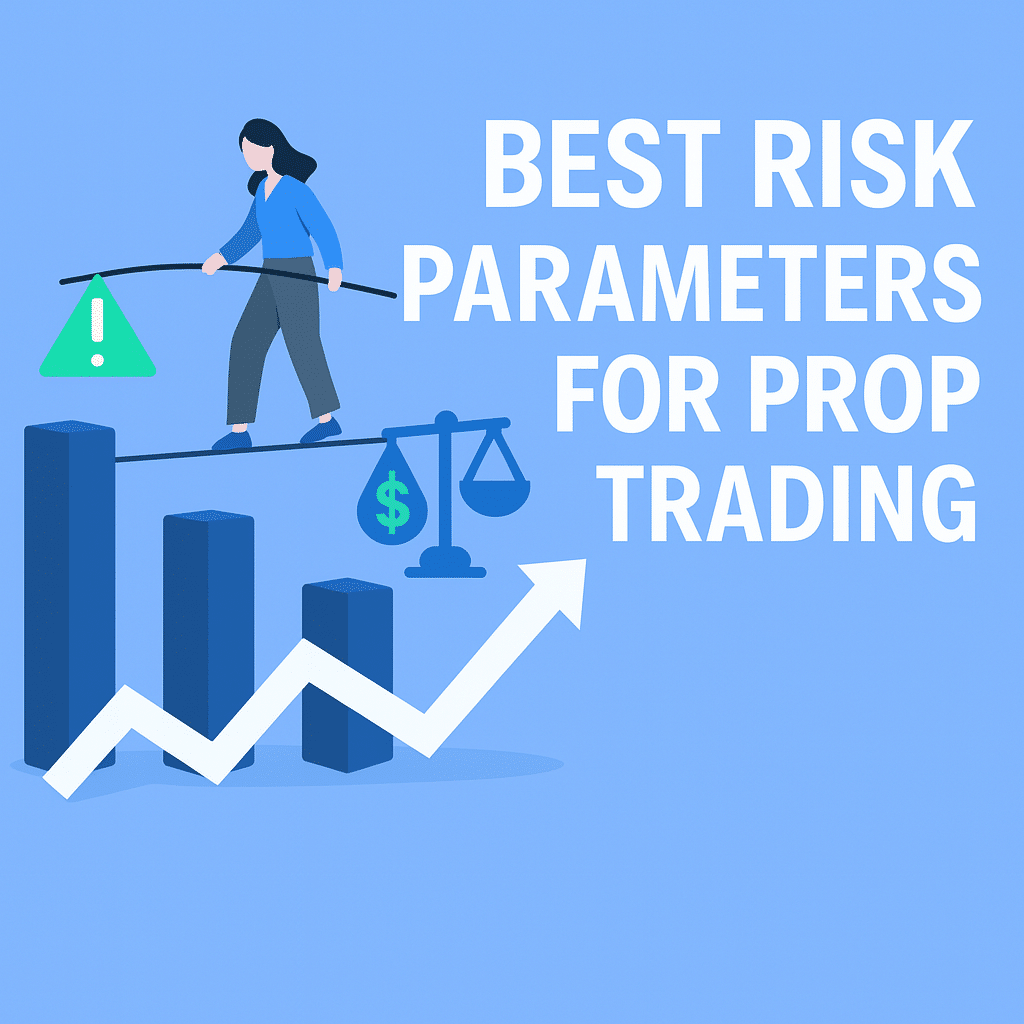Ideal Risk Settings for Passing Funded Challenges
In the world of proprietary trading, setting the best risk parameters for prop trading is crucial—especially when attempting to pass a funded challenge. These evaluations are specifically designed to test not only your profitability but also your discipline and consistency. Many traders make the mistake of focusing solely on hitting targets, but risk management is what ultimately determines long-term success.
In this guide, we’ll walk you through the optimal risk settings that can maximize your chances of passing prop trading challenges with confidence.
Understanding the Challenge Framework
Before discussing the best risk parameters for prop trading, it’s essential to understand how most funded challenges are structured. Typically, the challenge includes:
-
A profit target (e.g., 8%–10% within 30 days)
-
A maximum daily drawdown (e.g., 5%)
-
A total drawdown limit (e.g., 10%)
-
A minimum number of trading days
-
No breaking of specific rules (e.g., news trading restrictions, lot size rules)
These rules are not just formalities—they are there to test how well a trader can manage risk under pressure. That’s why your risk settings must align with these parameters.
Why Risk Parameters Matter More Than You Think
Many traders fail these challenges not because of poor market analysis, but due to poor risk practices. Even when you have a profitable strategy, a single oversized trade can wipe out days of gains. Therefore, you must establish consistent, repeatable settings that keep you within all limits.
Moreover, risk parameters give your trading structure. Instead of making emotional or impulsive decisions, you operate within a defined boundary, which enhances your overall discipline and mindset.
Key Components of the Best Risk Parameters for Prop Trading
Let’s break down the essential elements that make up a solid risk parameter plan:
1. Risk Per Trade
One of the most important decisions is how much of your capital you risk per trade. For most prop challenges, risking 0.5% or less per trade is ideal. This gives you enough room to withstand several losses without violating drawdown limits.
Even if your strategy has a high win rate, it’s wiser to start small. Scaling can come after you pass the evaluation and understand your funded account better.
2. Daily Risk Cap
Set a daily stop-loss limit that ensures you won’t hit the maximum daily drawdown allowed. If the challenge limit is 5%, aim for a personal daily limit of 2%–3%. This gives you a safety cushion and reduces the likelihood of being disqualified due to a bad trading day.
Transitioning between sessions or switching strategies? Always re-evaluate your daily risk cap accordingly.
3. Weekly Risk Plan
Although most challenges are measured by daily and total drawdowns, having a weekly risk plan keeps you focused over longer periods. Divide your overall risk into weekly goals. For instance, if you’re aiming for a 10% profit in 30 days, a 2.5% weekly profit target is more realistic and manageable.
This step-by-step approach reduces pressure and keeps your risk behavior consistent.
Subtle Adjustments That Make a Big Difference
Use a Dynamic Lot Size Strategy
Instead of using fixed lot sizes, adjust them based on your current account equity and market volatility. This technique allows you to maintain the same percentage risk even if your capital grows or shrinks during the challenge.
For example, after a series of winning trades, you may have more room to take slightly larger positions while still staying within your defined percentage risk.
Incorporate Time-Based Risk Filters
Avoid trading during highly volatile or uncertain times unless your strategy is designed for it. Many traders lose challenges due to unexpected market moves during news releases or market opens.
Some funded accounts, like those at Larsa Capital, have clear rules about high-impact news trading. Understanding and aligning your risk behavior with these conditions can significantly improve your odds of success.
Best Risk Parameters for Prop Trading in Different Market Conditions
Although fixed parameters are helpful, flexibility is also necessary. Here’s how to tailor your settings based on volatility:
-
High Volatility (e.g., CPI, FOMC weeks):
-
Lower your position size.
-
Reduce your daily risk limit by 20%.
-
Widen stop-loss levels with adjusted lot sizes.
-
-
Low Volatility:
-
Use tighter stop-loss and higher reward-to-risk trades.
-
Maintain standard risk levels but expect longer trade durations.
-
Being proactive in adjusting your parameters based on the market environment shows maturity and skill—qualities evaluators are looking for.
How Larsa Capital Encourages Smart Risk Practices
At Larsa Capital, traders are expected to maintain solid discipline throughout the evaluation phase. Their risk model favors traders who use consistent settings, respect drawdown limits, and demonstrate long-term potential rather than those who chase fast gains.
By using the best risk parameters for prop trading as discussed, you’ll be in a strong position to meet all of Larsa’s evaluation requirements while also building habits that benefit your long-term trading journey.
Tools and Habits to Support Risk Discipline
To ensure your risk parameters are consistently applied:
-
Use a risk calculator before every trade.
-
Journal every trade including the reasoning, entry, exit, and emotional state.
-
Set alarms or reminders to stop trading after hitting your daily limit.
-
Review weekly to identify pattern deviations or overtrading habits.
These small yet powerful habits help keep your discipline intact, especially during emotional market phases.
Final Thoughts
Passing a funded challenge isn’t just about technical analysis or market timing. It’s a test of your ability to control risk, stay consistent, and follow rules. By establishing the best risk parameters for prop trading, you give yourself the highest chance of not only passing the challenge but also thriving with real capital.
Success lies in consistency, and consistency begins with risk control. So whether you’re about to begin your evaluation or you’re already trading with Larsa Capital, let your risk parameters be your foundation—not an afterthought.

